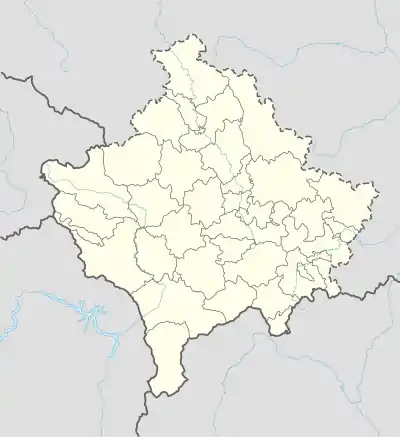Gërnçar
Grnčar | |
|---|---|
Village | |
 Gërnçar Location in Kosovo | |
| Coordinates: 42°19′34″N 21°24′58″E / 42.326°N 21.416°E | |
| Location | |
| District | Gjilan |
| Municipality | Klokot |
| Population (2011)[1] | |
| • Total | 240 |
| Time zone | UTC+1 (CET) |
| • Summer (DST) | UTC+2 (CEST) |
Grnčar (Serbian Cyrillic: Грнчар, Albanian: Gërncar), formerly Grnčare (Грнчаре, until 1975), is a village in the Klokot municipality, in southeastern Kosovo. It was formerly part of the Vitina municipality, then was together with Klokot and Vrbovac formed as part the Klokot municipality on 8 January 2010, based on the Ahtisaari plan. The village, and municipality, is a Kosovo Serb enclave. It has 240 inhabitants (2011 census). It is located in the geographical region of Gornja Morava, and is situated 583 m above sea level.
The village has a medieval church, dedicated to St. Nicholas. It was mined and destroyed by Albanians during the Kosovo War. There are archaeological sites located within the cadastral area. A palaeolithic cave is located below the St. Nicholas Church.[2] Remains of a Roman-era stone building are located 2,5 km from the village, on the left side of the Grnčar–Letnica road.[3] The locality of Gradište has remains of Roman, Byzantine and medieval fortification (2nd–14th c.).[4]
| Census | 1948 | 1953 | 1961 | 1971 | 1981 | 1991 | 2011 |
|---|---|---|---|---|---|---|---|
| Total | 374 | 447 | 456 | 516 | 523 | 477 | 240 |
Anthropology
According to the studies of A. Urošević, published in 1929, the village was inhabited by eight families in 31 houses; six Serb, one Albanian, and one Romani:[5]
- Irinići (5 houses, slava of St. Nicholas), Serbs, natives.
- Krčmarovići (8 h., St. Nicholas), Serbs, natives.
- Brankovići (4 h., St. Nicholas), Serbs, natives.
- Niševci (6 h., St. Nicholas), Serbs, very old settlers from the Niš area, hence their surname.
- Pejići (4 h., St. Nicholas), Serbs, moved from Žegra around 1850.
- Rustemovići (2 h.), belong to the Gashi fis (clan). Settled in 1878 as muhajirs from the Leskovac area.
- Hsini (1 h.) and Asanović (1 h.), Muslim Romani, moved, as labourers and blacksmiths, between many villages of Gornja Morava.